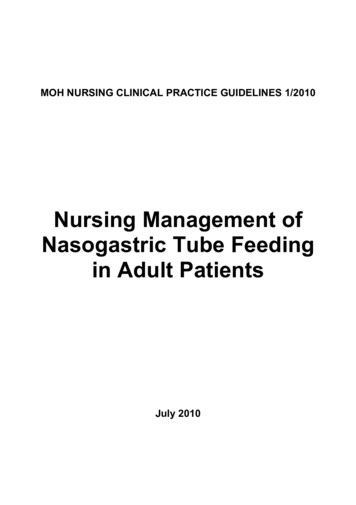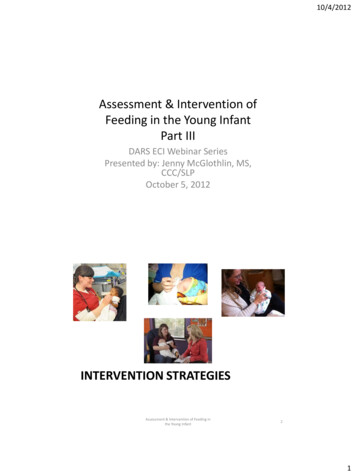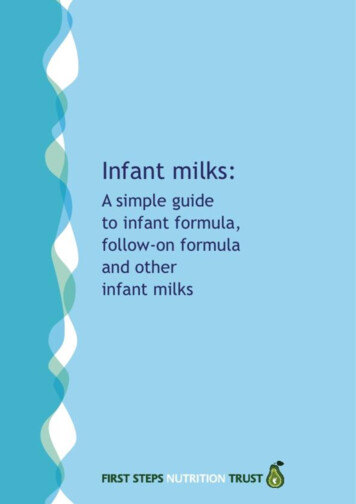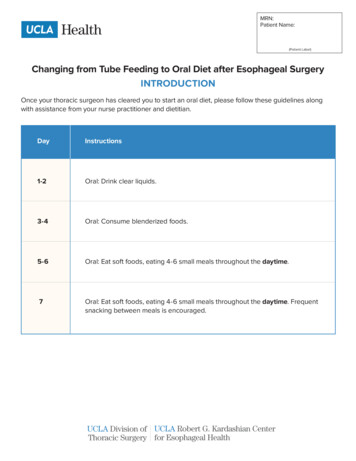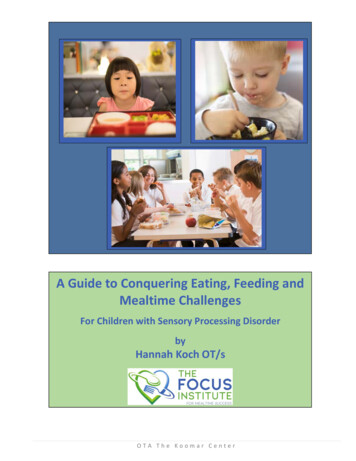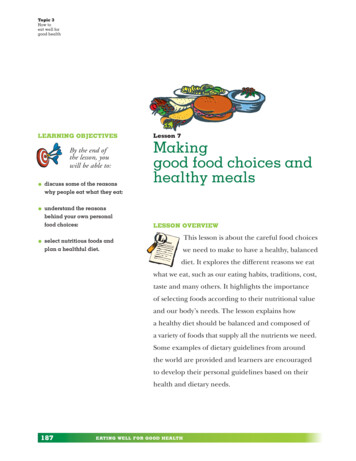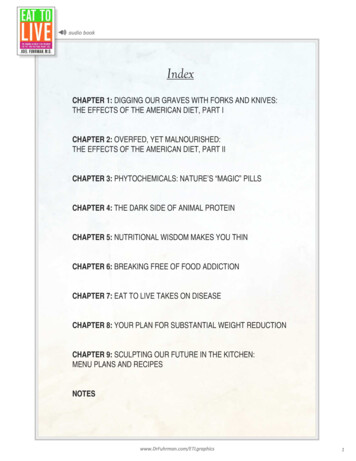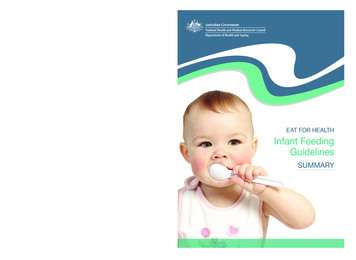
Transcription
EAT FOR HEALTHInfant health.gov.auGPO Box 1421, Canberra ACT 260116 Marcus Clarke Street, Canberra City ACTT. 13 000 NHMRC (13 000 64672) or 61 2 6217 9000 F. 61 2 6217 9100 E. nhmrc@nhmrc.gov.auN56b Infant Feeding Summary COVER FINAL.indd 130/05/13 2:16 PM
EAT FOR HEALTHInfant Feeding GuidelinesInformation for health workersSUMMARYN56b Infant Feeding Summary v08.indd 128/05/13 12:17 PM
Commonwealth of Australia 2013Paper-based publicationThis work is copyright. You may reproduce the whole or part of this work in unaltered form for yourown personal use or, if you are part of an organisation, for internal use within your organisation,but only if you or your organisation do not use the reproduction for any commercial purpose andretain this copyright notice and all disclaimer notices as part of that reproduction. Apart fromrights to use as permitted by the Copyright Act 1968 or allowed by this copyright notice, all otherrights are reserved and you are not allowed to reproduce the whole or any part of this work in anyway (electronic or otherwise) without first being given the specific written permission from theCommonwealth to do so. Requests and enquiries concerning reproduction and rights are to besent to Strategic Communications, National Health and Medical Research Council, GPO Box 1421,Canberra ACT 2600 or via email to nhmrc.publications@nhmrc.gov.au.ISBN Print: 1864965819 Commonwealth of Australia 2013Electronic documentThis work is copyright. You may download, display, print and reproduce the whole or part of this workin unaltered form for your own personal use or, if you are part of an organisation, for internal usewithin your organisation, but only if you or your organisation do not use the reproduction for anycommercial purpose and retain this copyright notice and all disclaimer notices as part of thatreproduction. Apart from rights to use as permitted by the Copyright Act 1968 or allowed by thiscopyright notice, all other rights are reserved and you are not allowed to reproduce the whole or anypart of this work in any way (electronic or otherwise) without first being given the specific writtenpermission from the Commonwealth to do so. Requests and enquiries concerning reproduction andrights are to be sent to Strategic Communications, National Health and Medical Research Council,GPO Box 1421, Canberra ACT 2600 or via email to nhmrc.publications@nhmrc.gov.au.ISBN Online: 1864965827NHMRC (National Health and Medical Research Council) (2013). Infant Feeding Guidelines: Summary.Canberra: National Health and Medical Research Council.To obtain information regarding NHMRC publications mrc.gov.auToll free 13 000 NHMRC (13 000 64672) or call (02) 6217 9000http://www.nhmrc.gov.auNHMRC Publication reference: N56bPublished: February 2013iiNational Health and Medical Research CouncilN56b Infant Feeding Summary v08.indd 228/05/13 12:17 PM
contentsHow to use this on of supportive social and physical environmentsfor breastfeeding4Special considerations6When an infant is not receiving breastmilk7Other fluids in infant feeding9The transition to solid foods10After 12 months12Caring for infants’ food13Nutrition in the second year of life14Other aspects of infant nutrition15Food allergies15Colic15Constipation16Dietary fat16Dental caries17Diarrhoeal disease18Infant Feeding Guidelines: SummaryN56b Infant Feeding Summary v08.indd 3iii28/05/13 12:17 PM
N56b Infant Feeding Summary v08.indd 428/05/13 12:17 PM
How to use this resourceThis document provides a summary of the Infant Feeding Guidelines from theNHMRC’s Eat for Health Program published in 2012.The Infant Feeding Guidelines are aimed at health workers to assist them inproviding consistent advice to the general public about breastfeeding and infantfeeding. They support optimum infant nutrition by providing a review of theevidence, and clear evidence-based recommendations on infant feeding forhealth workers.The main recommendations for infant feeding, including the introduction ofsolid food, are briefly described in this summary.The full text of the Infant Feeding Guidelines can be downloaded fromwww.eatforhealth.gov.au.DisclaimerThe Infant Feeding Guidelines and the information in this summary arerelevant to healthy, term infants of normal birth weight ( 2500g). Althoughmany of the principles of infant feeding described here can be applied to lowbirth weight infants, specific medical advice is recommended for pre-termand underweight infants.This document is a general guide to appropriate practice, to be followedsubject to the clinician’s judgement in each individual case.The Infant Feeding Guidelines are designed to provide information to assistdecision-making and are based on the best information available to the dateof compilation.Infant Feeding Guidelines: SummaryN56b Infant Feeding Summary v08.indd 1128/05/13 12:17 PM
OverviewAustralia is a nation in which breastfeeding is protected, promoted, supportedand valued by the whole of society.Breastfeeding provides major public health benefits. The nutrition and growthof infants has an important effect on early morbidity and mortality and thereis increasing evidence of the medium and long-term effects on health. Infantgrowth is now recognised as one of the influences on health and longevitylater in life and breastfeeding is the backbone of early nutrition.All health workers should promote breastfeeding in the community and ensurethat best practice in breastfeeding is followed. When mothers choose to useinfant formula it is also best practice to provide them with all of the informationand support that they need.The Marketing in Australia of Infant Formulas: Manufacturers and ImportersAgreement (MAIF) is based on the WHO International Code of Marketing ofBreast-milk Substitutes (the WHO Code) and provides the basis for controlof the marketing of infant formula in Australia.Australia’s breastfeeding initiationrate is good at 96%. However, only asmall proportion of women achievethe goal of exclusively breastfeedingto around 6 months. The role ofhealth workers in supportingbreastfeeding is important to furtherincrease Australia’s breastfeedinginitiation and duration rates.This summary provides backgroundinformation and recommendationsthat will help health professionalssupport parents and promote theabove objectives.2N56b Infant Feeding Summary v08.indd 228/05/13 12:17 PM
BreastfeedingBreastfeeding is the healthiest start for infants. Breastfeeding confers protectionagainst infection, some chronic diseases including type 1 and type 2 diabetes,coeliac disease and inflammatory bowel disease, is associated with lowercardiovascular disease risk factors including high blood pressure and elevatedtotal and LDL cholesterol and obesity. Breastfeeding also contributes to improvedcognitive development.There are also maternal benefits, with evidence for a reduced risk of ovarianand breast cancer, as well as a reduced risk of developing type 2 diabetesamong women with a history of gestational diabetes.In Australia, it is recommended that infants be exclusively breastfed untilaround 6 months of age when solid foods are introduced. It is furtherrecommended that breastfeeding be continued until 12 months of ageand beyond, for as long as the mother and child desire.While many mothers encounter some difficulties with breastfeeding, usuallythese can be overcome with support and encouragement from healthprofessionals, family and community organisations. Many mothers can alsocontinue breastfeeding if they choose to return to work. While exclusivebreastfeeding is ideal, any amount of breastmilk is beneficial to the infantand mother. If mothers express and store breastmilk, it is important tofollow correct procedures to ensure food safety and hygiene.RecommendationsX Encourage, support and promote exclusive breastfeedingto around 6 months of age.X Continue breastfeeding while introducing appropriate solidfoods until 12 months of age and beyond, for as long as themother and child desire.X While breastfeeding is recommended for the first 6 to12 months and beyond, any breastfeeding is beneficialto the infant and mother.Infant Feeding Guidelines: SummaryN56b Infant Feeding Summary v08.indd 3328/05/13 12:17 PM
Promotion of supportive social and physicalenvironments for breastfeedingThe active promotion and support of breastfeeding by community health, layand peer organisations, primary health care services, hospitals, and workplaceswill increase the proportion of women breastfeeding (both exclusive andnon-exclusive) up to age 6 months. The implementation of the Baby FriendlyHospital Initiative may also improve breastfeeding outcomes.Appropriate and effective positioning at the breast and correct attachment andmilking action are vital for the efficient removal of milk from the breast withoutnipple pain or trauma. Antenatal education on positioning and attachmenttechnique is recommended to prevent or reduce any nipple pain associatedwith breastfeeding.The use of a pacifier before 4 weeks of age may also be associated with areduced duration of breastfeeding (any, predominant and exclusive).Recommendations for individualsX Provide antenatal information and counselling about thebenefits and practical aspects of breastfeeding (and the risksof not breastfeeding) to all potential mothers, fathers andprimary carers.X Pay particular attention to positioning and attachment whenadvising on breastfeeding.X Take steps to identify breastfeeding difficulties by askingappropriate questions during any health-related visits withthe mother. Manage those difficulties if appropriatelyqualified, or refer to a health professional for management(e.g. lactation consultant).X Provide postnatal breastfeeding support information.X A pacifier (dummy) may be offered, while placing infant inback-to-sleep-position, no earlier than 4 weeks of age andafter breastfeeding has been established.4N56b Infant Feeding Summary v08.indd 428/05/13 12:17 PM
Recommendations for creating a supportiveenvironmentX Promote the principles of the Baby Friendly Hospital Initiative.X Encourage caregivers to access community-based servicessupporting breastfeeding families: such services are ofincreasing importance as the length of hospital stays decrease.X Encourage support in the community and workplace for flexiblework schedules, suitable environments for breastfeeding,expressing breastmilk, storage of expressed breastmilk andchild care. Encourage the use of available paid parental leaveschemes and lactation break entitlements.X Continue to implement the WHO International Code ofMarketing of Breast-milk Substitutes and the Marketing inAustralia of Infant Formulas: Manufacturers and ImportersAgreement and ensure that all health professionals understandtheir obligations.Infant Feeding Guidelines: SummaryN56b Infant Feeding Summary v08.indd 5528/05/13 12:17 PM
Special considerationsThere are very few contra-indications for breastfeeding. Maternal and paternalsmoking is negatively associated with breastfeeding duration and predominantor exclusive breastfeeding, but smoking and environmental contaminants arenot valid reasons to stop breastfeeding. In households where smoking occurs,infants who are breastfed have lower rates of respiratory infection.Consumption of moderate amounts of alcohol by breastfeeding women maybe associated with increased risk of adverse infant outcomes, but moderate,infrequent use of alcohol is not an indicator for stopping breastfeeding.Most prescription and over-the-counter drugs, and most maternal illnesses arenot indications for discontinuing breastfeeding.RecommendationsX Encourage mothers, fathers, primary carers and otherhousehold members who smoke to stop or reduce smokingand to avoid exposing the infant to tobacco smoke. Even ifparents persist with smoking, breastfeeding remains thebest choice.X Advise mothers that not drinking alcohol is the safest option.For women who choose to drink, provide advice on therecommended maximum intake level (e.g. two standarddrinks or less in any one day) and the optimal timing ofbreastfeeding in relation to intake.X Encourage and support mothers to avoid illicit drugs.X Most prescription drugs and medicines are compatible withbreastfeeding, but each case should be specifically assessedby a health professional. Statins should not generally beused during pregnancy or breastfeeding.X At present, breastfeeding is contra-indicated when a motheris known to be HIV positive (specialist advice is needed foreach individual case).6N56b Infant Feeding Summary v08.indd 628/05/13 12:17 PM
When an infant is not receiving breastmilkIf an infant is not breastfed or is partially breastfed, commercial infant formulasshould be used as an alternative to breastmilk until 12 months of age. It isimportant to prepare and store feeds correctly.RecommendationsX Parents should be informed of the benefits of breastfeedingand of the risks of not breastfeeding when a change frombreastfeeding is being considered.X If supplementary feeding is needed in hospital, it shouldonly be given for specific medical indications and with themother’s agreement.X Use cow’s milk-based formulas until 12 months of age(note: all infant formulas available in Australia areiron-fortified). Use special formulas only for infants whocannot take cow’s milk-based products or because ofspecific medical, cultural or religious reasons (note: neithersoy nor goat milk-based formulas are suitable alternativesfor infants with allergies to cow’s milk-based formulas unlessused under medical supervision).X Specialty formulas are indicated only for infants withconfirmed pathology: health care professionals shouldadvise parents accordingly.X Educate parents on the importance of correctly preparinginfant formula and following the instructions carefully,including using the correct scoop and not over-filling orunder-filling the scoop.X Infants are not at risk from C. Sakazakii when formula isprepared with lukewarm (body temperature), previouslyboiled water and fed within one hour. Infants may be at riskwhen conditions allow the bacteria to multiply to harmfullevels. The problem is encountered through poor storagepractices of infant formula (not preparation).Infant Feeding Guidelines: SummaryN56b Infant Feeding Summary v08.indd 7728/05/13 12:17 PM
When an infant is not receiving breastmilk (cont)Recommendations (cont)X Cow’s milk should not be given as the main drink to infantsunder 12 months, however small amounts may be used in thepreparation of solid foods.X As with breastfeeding, bottle feeding according to needis appropriate. It is important for parents to be aware thatinformation on formula packages recommending certainamounts for various ages is a guide only and does notnecessarily suit every infant.8N56b Infant Feeding Summary v08.indd 828/05/13 12:17 PM
Other fluids in infant feedingFor infants over the age of 6 months or for those who are not exclusivelybreastfed, tap water is preferred (as consistent with the Australian DietaryGuidelines) but this should be boiled and cooled for infants until 12 monthsof age. Consumption of fruit juice may interfere with the intake of nutrientdense foods and fluids and increase the risk of damaging emerging teeth.Tea, herbal teas, coffee and other beverages are of no known benefit to aninfant and could possibly be harmful.RecommendationsX Exclusively breastfed infants do not require additional fluidsup to 6 months of age.X Boil and cool any tap water that is to be given to an infant.Plain bottled water (but not natural or sparkling mineral wateror soda water) can be used if unopened to prepare formula,but it is not necessary.X A cup can be introduced at around 6 months, to teach infantsthe skill of sipping from a cup.X Fruit juice is not necessary or recommended for infants.Consumption may interfere with their intake of breastmilkor infant formula.X Do not offer tea, herbal teas, coffee, soft drinks, cordials orother beverages.X Any unmodified milk from non-human species, for examplecow’s, goat’s and sheep’s milk is not suitable for human infants,and should not be given as a main drink before 12 months.Infant Feeding Guidelines: SummaryN56b Infant Feeding Summary v08.indd 9928/05/13 12:17 PM
The transition to solid foodsAt around the age of 6 months, infants are physiologically and developmentallyready for new foods, textures and modes of feeding, and they need morenutrients than can be provided by breastmilk or formula alone. By 12 months ofage, a variety of nutritious foods from the Five Food Groups, as described inthe Australian Guide to Healthy Eating, is recommended.RecommendationsX Introduce solid foods at around 6 months, to meet the infant’sincreasing nutritional and developmental needs.X To prevent iron deficiency, iron-containing nutritious foodsare recommended to be the first foods. Iron containing foodsinclude iron-fortified cereals, pureed meat and poultry dishes.Cooked plain tofu and legumes/beans are also sources ofiron. Care needs to be taken particularly with a plant-baseddiet to ensure that supplies of iron are adequate. This is animportant issue because of the neuro-cognitive developmentimplications.X Foods can be introduced in any order provided iron-richnutritious foods are the first foods and the texture is suitablefor the infant’s stage of development. Cow’s milk productsincluding full-fat yoghurt, cheese and custard may be given,but not cow’s milk as a main drink before 12 months.X Ensure that solid foods are of appropriate texture. The textureof foods that are introduced should be suited to an infant’sdevelopmental stages, moving from pureed to lumpy tonormal textures during the 6-12 month period.X Avoid whole nuts and other hard foods to reduce the riskof choking.X Do not add sugar or honey to infant foods as this increasesthe risk of dental caries.10N56b Infant Feeding Summary v08.indd 1028/05/13 12:17 PM
The transition to solid foods (cont)Recommendations (cont)X Avoid juices and sugar sweetened drinks. Limit intake of allfoods with added sugars.X Do not add salt to foods for infants. This is an important safetyissue as infant kidneys are immature and unable to excreteexcess salt.X Consumption of nutrient-poor discretionary foods with highlevels of saturated fat, added sugars, and/or added salt(e.g. cakes, biscuits and potato chips) should be avoided.Infant Feeding Guidelines: SummaryN56b Infant Feeding Summary v08.indd 111128/05/13 12:17 PM
After 12 monthsSolid foods should provide an increasing proportion of the energy intake after12 months of age. Offering a variety of nutritious foods is likely to help meetthe need for most nutrients and provide a basis for healthy eating habits.RecommendationsX Pasteurised full cream milk may be introduced to a child’sdiet as a drink at around 12 months of age and be continuedthroughout the second year of life, and beyond. It is anexcellent source of protein, calcium and other nutrients.Do not use unpasteurised cow’s or goat’s milk.X Low-fat and reduced-fat milks (skim milk and milk with2-2.5% fat) are not recommended in the first two yearsof life.X Soy (except fortified soy products and soy formula wherespecifically indicated), and other nutritionally incompletealternate milks or milk substitutes (e.g. goat’s milk, sheep’smilk, coconut milk, almond milk) are inappropriate alternativesto breastmilk, formula or pasteurised whole cow’s milk in thefirst two years of life.X Rice and oat milk can be used after 12 months, as long as afull-fat, fortified variety (at least 100mg of calcium per 100ml)is used and alternative forms of protein and vitamin B12 areincluded in the diet. These products are suitable when usedunder health professional supervision.X Toddler milks and special and/or supplementary foods fortoddlers are not required for healthy children.X From 12 months of age and beyond, toddlers should beconsuming family foods consistent with the AustralianDietary Guidelines.X Milk and other drinks should be offered in a cup rather thana feeding bottle.12N56b Infant Feeding Summary v08.indd 1228/05/13 12:17 PM
Caring for infants’ foodAll foods given to infants should be nutritious and be fed in a safe way. Foodsprovided to an infant must be free of pathogens and of suitable quantity, sizeand texture. Infants should be supervised during feeding. Propping the bottleagainst the infant’s mouth and leaving the infant to feed from the bottle withoutsupervision should be avoided as the infant may fall asleep with the bottle’steat still attached to their mouth, increasing the risk of choking, ear infectionand dental caries.RecommendationsX Store foods safely and prepare them hygienically.X To prevent botulism, do not feed honey to infants agedunder 12 months.X To prevent salmonella poisoning, cook all eggs thoroughly(i.e. until the white is completely set and yolk begins to thicken)and do not use uncooked products containing raw eggs suchas home-made ice cream or mayonnaise.X Hard, small, round and/or sticky solid foods are notrecommended because they can cause choking and aspiration.X Ensure that infants and toddlers are always supervisedduring feeding.X Avoid feeding an infant using a ‘propped’ bottle.Infant Feeding Guidelines: SummaryN56b Infant Feeding Summary v08.indd 131328/05/13 12:17 PM
Nutrition in the second year of lifeHealthy eating is important in the second year of life and builds onnutritionally sound practices established in infancy. It provides the energyand nutrients needed for growth and development; it develops a senseof taste; an acceptance and enjoyment of different family foods;and instils attitudes and practices that can form the basis for lifelonghealth-promoting eating patterns.14N56b Infant Feeding Summary v08.indd 1428/05/13 12:17 PM
Other aspects of infant nutritionFood allergiesBreastfeeding may be associated with a reduced risk of atopic disease ininfants with and without a family history of atopy. Introducing a variety ofsolid foods around the age of 6 months is consistent with reducing the riskof developing allergic syndromes. There is no evidence that delaying theintroduction of solid foods beyond this age reduces the risk of atopic disease.Delay in the introduction of solid foods until after the age of 6 months isassociated with increased risk of developing allergic syndromes.Treatment of proven food allergies involves avoiding foods known tocause symptoms.RecommendationsX Encourage exclusive breastfeeding for around 6 months.There is no particular order that is advised for the introductionof solid foods or rate that new foods can be introduced, otherthan first foods should be nutritious and iron-rich.X If food choices have to be restricted for medical reasons, seekthe advice of a dietitian or appropriate health care professionalto ensure that dietary intake continues to meet nutrient andenergy needs.ColicChanges in diets and restrictions on individual foods have had limited successin the treatment of colic. Research into this common area of concern is ongoing,but at this point no specific dietary recommendations for the treatment of coliccan be made.RecommendationX Ensure that any dietary modification or pharmacologicalintervention is safe and does not result in nutritionaldeficiencies.Infant Feeding Guidelines: SummaryN56b Infant Feeding Summary v08.indd 151528/05/13 12:17 PM
ConstipationTrue constipation is infrequent in breastfed infants. If parents are concerned,they should consult an appropriate health professional.RecommendationsX To avoid unnecessary intervention, inform parents about thewide variation in normal bowel function in infants (particularlythose who are breastfed). If parents are concerned, they shouldconsult an appropriate health professional.X Health professionals should check that infant formula is preparedaccording to instructions (i.e. to the correct concentration).Dietary fatDietary fat is an important source of energy. Some fats provide essential fattyacids. Fat is also needed for the absorption of essential fat-soluble vitamins.RecommendationsX Restriction of dietary fat is not recommended during thefirst two years of life because it may compromise the intakeof energy and essential fatty acids and adversely affectgrowth, development, and the myelination of the centralnervous system.X Consumption of nutrient-poor discretionary foods with highlevels of saturated fat (e.g. cakes, biscuits and potato chips)should be avoided.16N56b Infant Feeding Summary v08.indd 1628/05/13 12:17 PM
Dental cariesThe prevalence of dental caries is lower where infants and children have accessto fluoridated water and by avoiding exposure of teeth to sugar-containingfoods and liquids. However excessive fluoride intake can cause dental fluorosis.Frequent consumption of foods containing added sugars in childhood increasesthe risk of dental caries, as does putting an infant to bed with a bottle.RecommendationsX Fluoride supplementation is not recommended.X For children between the ages of 6 months and 2 years whoare living in areas where the household water supply is notfluoridated, seek advice from a dentist. Advice will relate tothe region or state in which the infant lives.X Put an infant to bed without a bottle or take the bottle awaywhen the infant has finished feeding or before they fall asleep;don’t let the infant keep sucking on the bottle.X Avoid leaving an infant unattended with a bottle containingliquids (i.e. no bottle propping).X Do not dip pacifiers or bottle teats in sugar, jam, honey or anyother sugary substance.X Avoid juices and sugar-sweetened drinks and foods and drinkswith added sugars.X Don’t put anything in an infant’s mouth if it has been insomeone else’s mouth to avoid spreading bacteria that causedental caries.Infant Feeding Guidelines: SummaryN56b Infant Feeding Summary v08.indd 171728/05/13 12:17 PM
Diarrhoeal diseaseMild to moderate dehydration associated with gastroenteritis should be managedwith continued breastfeeding and, if required, oral rehydration therapy on theadvice of a health professional. Formula fed infants may require interruptionof formula for rehydration, but this should be resumed as soon as the infantis rehydrated. Lactose malabsorption in formula fed infants may require useof a low-lactose formula. Early reintroduction of food, following a bout ofgastroenteritis, is beneficial. Weight loss is the best guide to level of dehydrationand any infant suspected of suffering dehydration should be assessed by amedical practitioner.RecommendationsX For breastfed infants, continue breastfeeding whilesupplementing their fluid intake with an oral electrolytesolution as necessary.X Manage mild to moderate dehydration with an age appropriateoral electrolyte solution and early re-feeding.X For formula fed infants, it may be necessary to briefly interruptfeeding for rehydration.X Any infant suspected of suffering dehydration should beassessed by a medical practitioner.18N56b Infant Feeding Summary v08.indd 1828/05/13 12:17 PM
N56b Infant Feeding Summary v08.indd 1928/05/13 12:17 PM
N56b Infant Feeding Summary v08.indd 2028/05/13 12:17 PM
EAT FOR HEALTHInfant health.gov.auGPO Box 1421, Canberra ACT 260116 Marcus Clarke Street, Canberra City ACTT. 13 000 NHMRC (13 000 64672) or 61 2 6217 9000 F. 61 2 6217 9100 E. nhmrc@nhmrc.gov.auN56b Infant Feeding Summary COVER FINAL.indd 130/05/13 2:16 PM
Breast-milk Substitutes (the WHO Code) and provides the basis for control of the marketing of infant formula in Australia. Australia's breastfeeding initiation rate is good at 96%. However, only a small proportion of women achieve the goal of exclusively breastfeeding to around 6 months. The role of health workers in supporting
